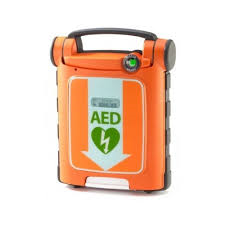
AED, or automated external defibrillator, or commonly known as the Automatic Defibrillator , is a lifesaving computerized medical apparatus which is designed to be used by untrained bystanders in case of emergency. This device is lightweight and portable, it runs by a battery installed in it. You probably have seen it at schools, offices, public buildings airports, Walmarts and basically in many public places. Awareness programs to use this device have been going on TV shows, theatres, and other public gatherings. However, fictions or movies where you see the doctor rubbing the defibrillator paddles together just before giving the shock – that scene is quite wrong! In reality, rubbing that way can cause the device to malfunction. Rubbing was useful once upon a time when they used conductive gels on the paddles, but using gel on defibrillator paddles got out-fashioned long ago. And no, defibrillator shock never causes a patient to have such intense body spasm!
Defibrillation, i.e. the procedure functioned by the defibrillator device, is required when the heart of a person beats too fast, hence the heart isn’t actually pumping out the required amount of blood to the whole body. By defibrillation procedure, an electric charge helps that heart to restore its normal heartbeat functionality.
What is an automatic defibrillator and how it functions?
It’s a medical apparatus with an electronic chip inside of it, which can automatically detect (when the pads are placed at the appropriate areas on the bare chest of the patient) if a person needs shock to restore his/her cardiac situation at the moment of emergency and then delivers the shock, if needed. It is powered by a battery and portable handheld device, hence no external electrical power needed to operate the same.
In case of a cardiac arrest, there can be 3 types of disorders. First, the person has no electrical charge at all, it’s called asystole. Secondly, the heartbeat is too rapid and that is preventing the heart chambers to be filled by blood sufficiently, and the medical term we use to explain this condition is tachycardia. Or third, the heartbeat is irregular due to disorganized electric current and hence it’s preventing the heart muscles to have a proper contraction, therefore the body isn’t getting the right amount of blood circulation to function properly. This condition is named as fibrillation.

A defibrillation procedure can’t help a person with asystole. However, it can save a life in case of the other 2 disorders, tachycardia and fibrillation, if performed within the stipulated period.
The automatic defibrillator device, when properly installed on the chest of a patient in need, can check his/her conditions by its own electronic chip and can detect that if he/she really needed the shock. Therefore, even an untrained person can operate and perform this procedure very easily by listening to step-by-step automated verbal instruction coming from the device. The device is smart enough already and require absolutely no medical experience to handle if one has an average IQ to follow easy verbal instruction. However, one has to be calm and should be mentally stable to listen to the automated prompt and follow the procedure as per the same. Once a person having a cardiac arrest, he/she has very limited time to be able to get benefitted by a defibrillation procedure. If performed within 1 minute, the chance of survival is 90%. And the chance gets decreased by a whopping 10% with every extra minute. So, the person who is performing this defibrillation procedure should be in his/her right state of mind to act sanely at that crucial time.
